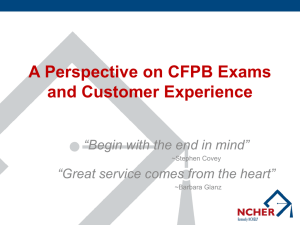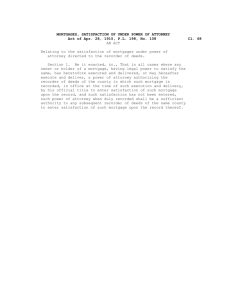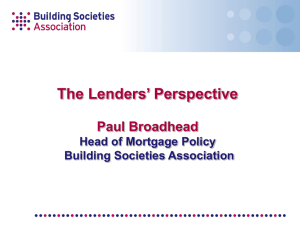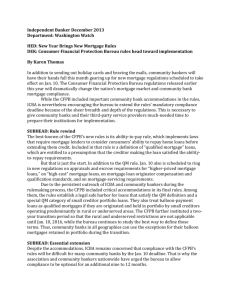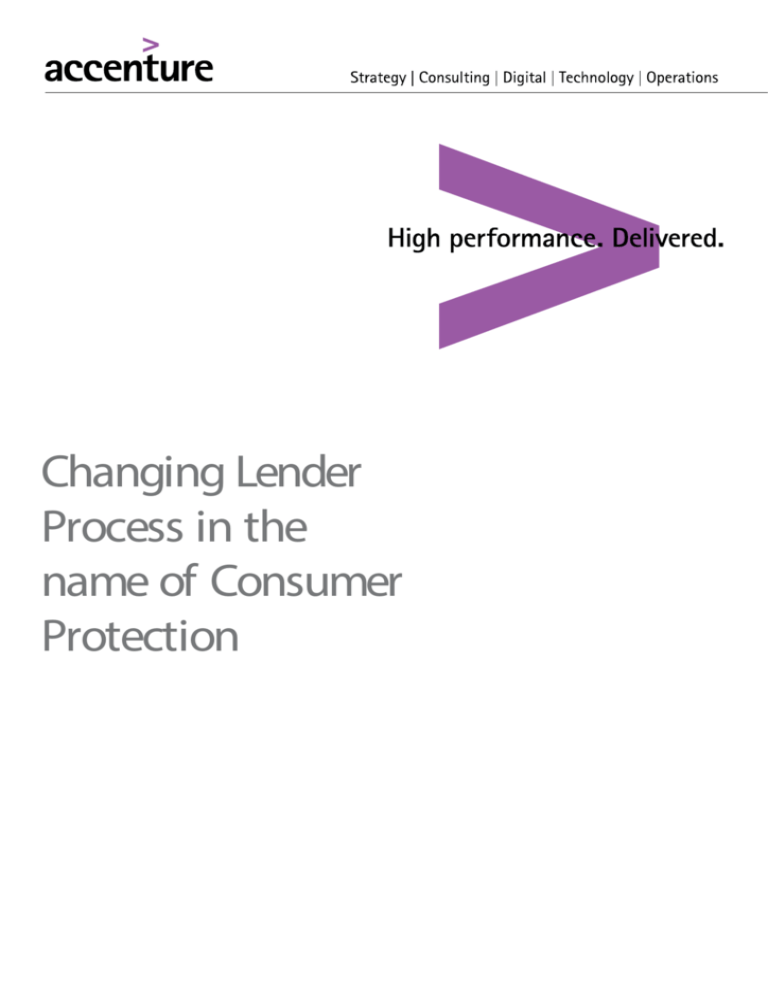
Changing Lender
Process in the
name of Consumer
Protection
In the first white paper in this series, we focused on
consumer protection as the new mandate handed down
to the industry from the new federal regulator, the
Consumer Financial Protection Bureau (CFPB or Bureau).
While consumer protection has always been a concern
for lenders and regulators, there was a difference in
the way the government delivered its oversight and its
ultimate objectives. In the past, regulator efforts to protect
consumers were prioritized by the risks these consumers
could pose to the safety and soundness of the institution
if they took action, such as filing a class action lawsuit. The
government was concerned, first and foremost, with the
safety and soundness of the regulated institution and the
banking system at large.
Under the new regulatory scheme, the Consumer Financial
Protection Bureau puts mortgage lenders and third-party
settlement service providers on notice: Compliance will be
judged by the extent to which consumers have access to
financial products and services and that such offerings are
fair, transparent, and competitive. Today, it’s the consumer
the government is out to protect, not the institution
it regulates.
2 Accenture Whitepaper Series II
As the mortgage industry moves into this
new era of consumer protection, executives
face a new question: How is fairness,
transparency, and competitiveness to be
measured? For many lenders and their
vendors, customer satisfaction has been
a standard reporting and compliance
measure. But is this old standard sufficient
now that the regulatory pendulum has
swung away from business as usual?
Ultimately, how will lenders balance the
need to comply with the government’s
consumer protection regulations with the
business imperative of profit? In this paper,
we will discuss the operational changes
that mortgage lenders must consider in this
environment if they hope to achieve this
balance. In the final paper in this series, we’ll
discuss how IT plays a major role in meeting
this objective.
Customer Satisfaction is on the rise! Or is it?
From the moment the CFPB began
organizing itself into what would become
one of the federal government’s largest
bureaus, their focus has been squarely
on the consumer. The organization’s
name, in hindsight, should have provided
some clue to the industry as to the types
of rules that the new bureau would be
writing. Unfortunately, the industry was
so preoccupied with complying with
consent orders, defending repurchases,
driving volume in an extremely tight credit
environment and maximizing federal
subsidies to mortgage credit for programs
like HAMP and HARP, that it could afford
little if any attention to the actions of its
newest regulator. Despite this, some lenders
were able to create transparent, consumerfriendly and consumer-safe business
models. The result: at least one survey
found consumers to be more satisfied with
their mortgage lenders than they’ve been
in years.
In a recent survey by J.D. Power &
Associates (2012), customers’ overall
satisfaction with mortgage lenders “has
reached its highest level in the past six
years,” according to the authors. (See Chart)
The survey further reports that, on a 1,000point scale, overall customer satisfaction
has increased to 761 in 2012, up from 747
in 2011, and 734 in 2010. The survey cites
improvements in both transparency and
communication as primary factors in these
improvements.1
Mortgage Originator
Customer Satisfaction Rating
(Scale of 1,000)
761
747
734
2010
2012
Source: J.D. Power and Associates 2012 U.S.
Primary Mortgage Origination Satisfaction StudySM
A more recent survey of loan servicing
customers by the same firm (J.D. Power,
2013), finds that overall satisfaction with
primary mortgage servicers has increased
to 733 (on a 1,000-point scale) from
725 in 2012.2 Like the 2012 mortgage
origination survey, some of these gains are
attributed to new rules promulgated by the
consumer bureau.
1. J.D. Power (2012) U.S. Primary Mortgage Origination Satisfaction StudySM. Available online at:
http://www.jdpower.com/content/press-release/kzLBNiz/2012-u-s-primary-mortgage-origination-satisfaction-study.htm
2. J.D. Power (2013) U.S. Primary Mortgage Servicer Satisfaction StudySM. Available online at:
http://www.jdpower.com/content/study/n1Miqmu/2013-u-s-primary-mortgage-servicer-satisfaction-study-results.htm
3 Accenture Whitepaper Series II
2011
Let’s take a moment to put this good news
into perspective.
The CFPB Customer Complaint Database
In its 2012 mortgage loan originator
consumer survey, JD Power looked at
and provided awards in five areas of the
business: application/approval process, loan
representative, closing, contact and overall
satisfaction. Only a single lender scored 5
out of 5 on the surveyor’s scale, and that
institution scored only 817 out of 1,000,
barely a B grade. Every other financial
institution surveyed, including the nation’s
largest institutions, performed worse, some
far worse. While the industry’s overall
performance at 761 is the highest we’ve
seen in more than half a decade, it’s only
a 1.5% improvement over last year and a
2.7% improvement from 2010.
One need not look at J.D. Power for an
analysis of how the mortgage servicing
industry performed in 2012, for this was
the year of the historic servicing industry
settlement. The second largest civil
settlement ever obtained by the state
attorneys general, second only to the
tobacco settlement, will cost the nation’s
five largest mortgage servicers, which
control about 60 percent of the mortgage
servicing market, an estimated $25 to $32
billion, according to the Office of Mortgage
Servicing Oversight.3
Anyone operating in the U.S. home finance
industry that puts their faith in a headline
promising increasing satisfaction on the
part of American homebuyers or owners
is cautioned to think twice. Not only is the
improvement small by any standard, J.D.
Power & Associates is likely to be the last
place the new federal regulator will look
for signs of verifiable improvement. The
first place the CFPB will look will be its
own database.
When George Orwell gave us his novel 1984,
he envisioned a government obsessed with
observing its citizens. It was a brilliant
and prophetic work, but not even Orwell
could have imagined a world in which
the governed were equally eager to see
the inner workings of their government.
We live in such a world today. A glance
at the increasing number of Freedom of
Information requests since that program
was enacted in 1966 is evidence of this as
are the millions of social media-connected
citizens who have “linked up” or “friended”
their elected leaders.
The current administration has embraced
this. Never before in the history of our
democratic government have we seen an
administration so open to connecting with
its constituents. The American people
have been invited into the virtual Oval
Office and their comments are receiving
responses, if not by the President himself,
at least by members of his social media
savvy staff. Consumers are being trained
to expect transparency and access through
digital networks.
Of all of the government agencies, the
Consumer Financial Protection Bureau
has been the best example of this type
of transparent, socially available agency.
The first thing the new bureau did was
to set up a website and create social
media connections that would allow it to
communicate directly with the consumers
it was charged with protecting. And this
has had a profound impact on the banking
industry, but not an unforeseen one.
3. Joint State-Federal Mortgage Servicing Settlement FAQ http://nationalmortgagesettlement.com/faq
4 Accenture Whitepaper Series II
Anyone operating
in the U.S. home
finance industry
that puts their
faith in a headline
promising increasing
satisfaction on the
part of American
homebuyers or
owners is cautioned
to think twice.
In the Accenture Banking 2020 Consumer
Survey report4, data clearly pointed to a
growing acceptance and even demand
on the part of consumers for information
delivered electronically. It should come as
no surprise that consumers have responded
favorably to the government’s attempts
to connect with them online. But this
also points to an opportunity for banks,
as the data clearly indicates that digital
banking has become essential. Consumers
view online banking as the single most
important area in which banks should invest
and develop.
Far from a casual overseer, the CFPB came
out with heavy fines against the credit
card industry early on and then began
collecting consumer complaint information
to use as a prod to keep the mortgage
industry moving down the path to a better
consumer experience.
One result of this data collection effort
has been the revelation that the things
mortgage customers loathe about the
mortgage origination and servicing
processes today are pretty much the same
things they have loathed for years. Chief
among them, being denied the credit they
feel they deserve.
By promising to
In the past, lenders dealt with this country’s
over-developed sense of entitlement by
developing new loan products, many of
them with requirements so lax that most
borrowers could not help but qualify. The
NINA loans with the drive-by closings spring
to mind. At least this allowed the industry
the opportunity to profit handsomely
for removing this source of borrower
frustration. That ended poorly.
the CFPB becomes
In the past, regulators used more carrot
than stick to get the industry to move in
the direction it wanted. The best example
of this was the availability of low-cost
funds to those institutions that helped
the government reach its goal of high
homeownership rates. Those institutions
that failed to fall into line found themselves
competing on a less than level playing field
when it came to home finance.
The CFPB officially began taking mortgage
complaints on its website in December
2011. By June 30, 2013, the CFPB had
received approximately 176,700 consumer
complaints, forty-eight percent of which,
about 85,000, concerned mortgage
transactions, according to the consumer
bureau’s most recent semi-annual report.
More than 144,800 (82 percent) complaints
received as of June 30, 2013 have been sent
by Consumer Response to companies for
review and response. The vast majority of
consumers’ complaints dealt with matters
relating to loan modifications, collections,
or foreclosures (62 percent). Other common
types of mortgage complaints, according to
the report, involved issues related to making
payments, such as loan servicing payments
or escrow accounts (24 percent). Few dealt
with mortgage origination complaints.
Today’s regulator uses both carrot and stick
to keep lenders in line and one of its sticks is
its public complaint database. By promising
to share information on the “bad” banks
with consumers, the CFPB becomes a source
of reputational risk to any bank that has
ever dissatisfied a consumer. This, of course,
is a majority of banks.
4. http://www.accenture.com/us-en/Pages/insight-capturing-emerging-opportunities-banking-summary.aspx
5 Accenture Whitepaper Series II
share information
on the “bad” banks
with consumers,
a source of
reputational risk to
any bank that has
ever dissatisfied a
consumer.
Adjudications from the CFPB
Another revelation provided by the public
CFPB complaint database is that the most
common mortgage complaints arise among
consumers having difficulty keeping up with
their mortgage payments. This should come
as no surprise; collection efforts, judicial
and non-judicial remedies such as loan
modifications, short sales, deeds-in-lieu of
foreclosure are often contentious. As such,
aggrieved borrowers are more likely to file a
complaint with the CFPB than are borrowers
with performing loans.
The Consumer Complaint Database allows
the public to know what is being complained
about and why, according to the Consumer
Bureau. Still, the public can’t really do much
with the information. There is no mechanism
that allows a consumer to use information
gleaned from the database to secure a
redress of alleged wrongs.
“Each and every time we hear from
American consumers about their
troublesome transactions with financial
products, it gives us important insight,”
said CFPB Director Richard Cordray. “The
information helps us and it should be
available to help others too. By making our
data publicly available… we hope to improve
the transparency and efficiency of this
essential consumer market.” 5
Lenders didn’t seem to agree with the
Director’s assessment, at least when the
database was announced in January,
2012, and then expanded in March 2012
to include, among other things, mortgage
related complaints. Initially, trade groups
worried that their member companies’ trade
secrets would be exposed and customer
privacy would be at risk, according to an
article in BusinessWeek.6 Additional industry
concerns included posting company
names without verifying the accuracy of
complaints, unfairly casting reputable
businesses in a bad light.
The median amount of monetary relief
reported was approximately $410 for the
600 mortgage complaints where companies
reported relief. Where the database
becomes a source of serious risk to the
industry is when the information it contains
is used by the CFPB itself. The bureau uses
this information to prompt what it calls a
“Target Review.”7 So far, the Administrative
Adjudications CFPB has pursued against
institutions with complaints in the database
have led to hundreds of millions of dollars
in restitution and fines. Lenders are welladvised to pay close attention to consumer
complaints, regardless of the claims’
voracity, to reduce or even avoid these
targeted reviews.
Additionally, it has become clear that the
CFPB’s actions against institutions that
receive consumer complaints are likely
to go well beyond the single-transaction
grievances. So far in 2013, the CFPB has
entered Administrative Adjudication
agreements with institutions covering
a range of bank processes, including
deceptive marketing tactics8, Truth-inLending violations9, illegal referral fees10 and
misleading customers.11
The industry response to the new
regulatory risk
The days of responding to consumer
dissatisfaction by loosening underwriting
standards and using a poorly or completely
uninformed secondary market for a
funding source through securitization
are over. The pendulum has now swung
back to the other end of the spectrum.
Underwriting standards and the availability
of loans, as well as interest rates pegged
to the borrower, property, and credit risks
associated with the loan transaction are the
new reality. So too is the realization that
any given customer’s level of satisfaction
with her or his transaction experience
isn’t enough to protect the lender from
CFPB scrutiny.
5. “CFPB Launches Consumer Complaint Database” June 19 2012
http://www.consumerfinance.gov/pressreleases/consumer-financial-protection-bureau-launches-consumer-complaint-database/
6. Banks Roused by the CFPB’s Database of Complaints (April 4, 2013), by Elizabeth Dwoskin and Frank Bass. Available at
http://www.businessweek.com/articles/2013-04-04/banks-roused-by-the-cfpbs-database-of-complaints
7. “CFPB Launches Consumer Complaint Database” June 19 2012
http://www.consumerfinance.gov/pressreleases/consumer-financial-protection-bureau-launches-consumer-complaint-database/
8. http://files.consumerfinance.gov/f/201306_cfpb_consent-order-004.pdf Dealers’ Financial Services, LLC, Lexington, Kentucky (6/26/13)
9. http://files.consumerfinance.gov/f/201306_cfpb_consent-order-003.pdf U.S. Bank National Association, Cincinnati, OH (6/26/13)
10. http://files.consumerfinance.gov/f/291305_cfpb_consent-order-0001.pdf Paul Taylor, Paul Taylor Homes Limited, and Paul Taylor Corp.
11. http://files.consumerfinance.gov/f/201308_cfpb_prehearing-brief.pdf
6 Accenture Whitepaper Series II
Despite the apparent increase in borrower
satisfaction with their lender, there
needs to be a great deal more focus on
those relatively few customers who voice
dissatisfaction with their experience.
This is exactly what the CFPB is doing
with substantial help from its Customer
Complaint Database.
Uncertainty about the final rules abounds.
Discussions with mortgage lenders and third
party settlement service providers suggest
reluctance within the mortgage industry
to launch extensive process re-engineering
or technology initiatives that don’t relate
directly to compliance concerns. These
industry professionals suggest that lenders’
legal departments continue to assess
the likely effects and true impact of the
new regulations. In the meantime, a new
industry of consultants and advisors are
emerging to advise the mortgage industry
on risk, reporting, and compliance in the
post Dodd-Frank era.
Some of these firms are providing guidance
and even mock audits in an effort to prepare
institutions to answer to the new regulator
as the rules go into effect. These firms aim
to assist their clients to sift through the
confusion and conjecture about where
the CFPB fits into the existing regulatory
structure and what the new regulatory
environment might look like. No one knows
exactly what to expect.
The CFPB is the newest member of the
Federal Financial Institutions Examination
Council (see chart), an interagency group
representing five federal regulators that
work together to lay down the standards
by which financial institutions will be
examined. It’s not yet clear to bank
executives whether the CFPB will examine
them separately or jointly with other FFIEC
regulators.12
So, what is the best strategy for an
institution to embrace in order to put it
in good stead with the new regulator as
the rules come online? Since much of the
“letter of the law,” or the rules, have yet
to be written, lenders will be best served
by focusing on the “spirit of the law.”
This requires us to carefully examine our
processes and their ultimate impact on the
consumer experience.
Members of the Federal
Financial Institutions
Examination Council (FFIEC)
• Board of Governors of the Federal
Reserve System
• Federal Deposit Insurance Corporation
• National Credit Union Administration
• Office of the Comptroller of the Currency
Adjusting our process to meet the new
federal mandates
We recommend three process changes that
institutions should consider at once in order
to prepare effectively for more stringent
regulator oversight. The first of these
concerns actions taken in the planning and
budgeting office. The second is an addition
to the traditional QA/QC function. The third
relates to re-engineering the customer
service department.
Establish a separate budget for Customer
Relationship Management
CRM in the financial services industry has
largely been a case of failure to launch,
especially in the mortgage department.
As the industry implemented technologies
designed to close loans faster, and to reduce
costs, borrowers remained customers of the
mortgage originator for a shortened period
of time. As soon as the deal was closed, the
loan was either sold or the servicing rights
were transferred (or both). For all practical
purposes, the borrower became someone
else’s customer, and as the industry
discovered, all too often their problem
as well.
12. http://www.bankinfosecurity.com/cfpb-what-new-regulators-role-a-5915/op-1
7 Accenture Whitepaper Series II
• Consumer Financial Protection Bureau
Goal: interagency body empowered to
prescribe uniform principles, standards, and
report forms for the federal examination of
financial institutions.
Until the historic refinance boom, mortgage
loan borrowers came back to the closing
table only once every 7 years or so. There
was no CRM software available that could
nurture a lead for that long. In most cases,
those leads were never tracked. Instead,
lenders turned to business partners, realtors
and title agents, who could provide leads
that would close much sooner.
By the height of the refinance boom that
blossomed at the turn of this century, most
of the mortgage loan originators working in
the business had forgotten all about leads
from business partners or any other source
and were instead trying to answer the
phone and capture as much of the bountiful
business as they could in the time they had
available. The industry’s sales staff had
become a corps of order takers. For the most
part, the majority of banks still capture their
business this way. They answer the phone
when a borrower needs a home loan.
While this may have been acceptable when
there were no lasting, serious side effects of
a dissatisfied borrower, it will not suffice in
the post Dodd-Frank era. Lenders would do
well to begin now by establishing a real CRM
budget and making an executive within the
institution accountable. This budget should
not be part of the bank’s normal marketing
budget, but a separate investment in
software, systems and management tools
specifically for engaging and tracking
mortgage customers.
As lenders make these investments,
analytical tools will be a critical
consideration. Analytics represents a key
component of the bank’s CRM process.
Applying analytics will allow them to
anticipate their borrower’s needs faster and
more accurately. It will be the difference
between proactive customer management,
where the bank systematically deepens
customer relationships and benefits from
customer loyalty and a greater share of
wallet, and reactive customer management,
where the bank must chase its customers
for new business.
Establish routine monitoring of the CFPB’s
complaint database
Traditionally, lenders have focused on
monitoring a number of elements internal
to the loans they process. They monitor
their consumer’s credit through the process,
the value of the collateral and the actions
of their staff in order to avoid legal noncompliance. Now, we need to add another
task to the teams monitoring the health of
the institution and its borrowers.
Someone within the institution should be
monitoring the CFPB’s complaint database
on a regular basis. In the case where a
complaint is lodged against the bank, steps
should be taken at once to ensure and
document that the fault, if there is one, is
a unique circumstance and not a pattern
of behavior.
The database is public in respect to the
institutions that receive complaints, but it
masks the information about the consumer
filing a complaint, so it may not be possible
for the bank to respond directly to the
borrower filing the grievance. What it will
do is highlight areas of the bank’s operation
that may pose future risks of customer
satisfaction. Moving forward on initiatives
designed to prevent or reduce future
customer dissatisfaction will stand in the
bank’s favor during an audit.
8 Accenture Whitepaper Series II
Moving forward
on initiatives
designed to
prevent or reduce
future customer
dissatisfaction
will stand in
the bank’s favor
during an audit.
Additionally, tracking and responding
to CFPB complaints in a formalized way
establishes a pattern of behavior geared to
improve the customer’s overall experience.
Integrating customer complaints lodged
with the CFPB with the bank’s own customer
complaint processing organization offers
a holistic picture of the bank’s consumer
satisfaction, consumer protection, and
complaint feedback system. This is directly
in line with the spirit of the CFPB’s consumer
protection mandate.
The best banks will respond in this manner,
but not all of them will apply human
resources to this task. In many cases, banks
will automate this monitoring function,
embedding controls within their existing
process that raise flags early and allow the
bank to react in a proactive fashion without
incurring the burden of additional fulltime employees.
Enabling customer self service
Allowing the customer to interact with
the bank’s technology in order to receive
informational updates without waiting for
bank personnel will be viewed by most as
a technology initiative. In fact, there is a
major technology component and we’ll deal
with that in the next white paper in this
series. In truth, the bank’s ability to offer
self service to its customers starts with
process re-engineering.
Regardless of what any technology
vendor claims, banks cannot just present
technology that opens up the door to their
database of record; not without significant
risk to data quality or consumer privacy.
The institution must first carefully consider
what information can be accessed, by
whom and under what conditions. While
technology vendors are quick to point out
that business rules consulting is provided
as part of the sale, these are considerations
that the bank will consider internally
before any specific technology tools are
considered, most likely with the support of
external consultants.
Allowing the
But the bank must take care not to consider
this question only from the risk perspective.
It must also be considered in regard to
customer satisfaction. When Interactive
Voice Response telephone systems were
first made available, IVR was viewed
by most industries as a godsend. It was
expected that customers would embrace
the ability to get all the information they
wanted without ever having to wait on a
human operator. Today, IVR is referred to
as “voice mail hell” by many consumers.
Just because a technology allows a
consumer self service does not mean it will
improve their overall experience. Changes
made in this area must achieve customer
satisfaction if the bank hopes to comply
with CFPB regulations.
waiting for bank
9 Accenture Whitepaper Series II
customer to
interact with the
bank’s technology
in order to receive
informational
updates without
personnel will be
viewed by most
as a technology
initiative.
Avoiding the risks that come with change
In today’s mortgage business, mistakes are
costly. Change is a process that opens up
organizations to the possibility of making
mistakes, by its very nature. Responding
appropriately to change without making
mistakes that will cause the firm to fall out
of compliance with federal regulators is
a key success factor in this environment,
which seeks transparency and clear and
regular communication, while encouraging
innovation in bringing new products and
services to market.
No better evidence for this can be found in
the new products industry technologists
have brought to lenders so far this year.
Nearly every new innovation we have
seen has been built around the intended
or unintended consequences of the
new compliance rules. Vendors know
that these are the issues that drive the
lenders’ “Actions Items” list, so new
appraisal ordering technology, loan officer
compensation models and LOS audit trail
technologies are the newest shiny objects
tempting bankers.
Best practices include careful advance
planning, adequate project budgeting,
thorough employee education, staggered
rollout, ongoing training and managing to
any new metrics in a visible way. Institutions
are urged to view any silver bullet solutions
with distrust until their efficacy has been
thoroughly established.
Ultimately, successful change management
is an occupation unto itself. The important
thing to recall is that the changes discussed
in this paper and the others in this series
are not suggestions that banks may wish
to implement for a competitive advantage,
but rather represent change that is being
forced upon our industry by new regulatory
oversight. It is important for institutions to
succeed in these efforts.
Conclusion
Both the letter and the spirit of the new
Dodd-Frank legislation and the rules the
CFPB is writing to define them are centered
squarely on consumer protection. As the
final wording of major rules are being
finalized and amended, the industry’s best
chance of staying compliant is to begin
thinking in terms of improving the borrower
experience. For now, at least, protecting
the consumer is being treated as a synonym
for pleasing the consumer. Customer
satisfaction has become the metric by
which the regulator measures fairness
and transparency.
Improving customer service in our industry
is a regulatory mandate and firms will
be working to meet this goal in various
ways. No firm will achieve success without
changing their processes. Those that do this
while opening themselves up the least to
compliance errors will be most successful.
In the next paper, we’ll talk about how
technology can decrease this burden. ■
10 Accenture Whitepaper Series II
About Accenture
Accenture is a global management consulting, technology services and outsourcing
company, with approximately 281,000 people serving clients in more than 120 countries.
Combining unparalleled experience, comprehensive capabilities across all industries and
business functions, and extensive research on the world’s most successful companies,
Accenture collaborates with clients to help them become high-performance businesses and
governments. The company generated net revenues of US$28.6 billion for the fiscal year
ended Aug. 31, 2013. Its home page is www.accenture.com.
11 Accenture Whitepaper Series II
Copyright © 2014 Accenture
All rights reserved.
Accenture, its logo, and
High Performance Delivered
are trademarks of Accenture.


